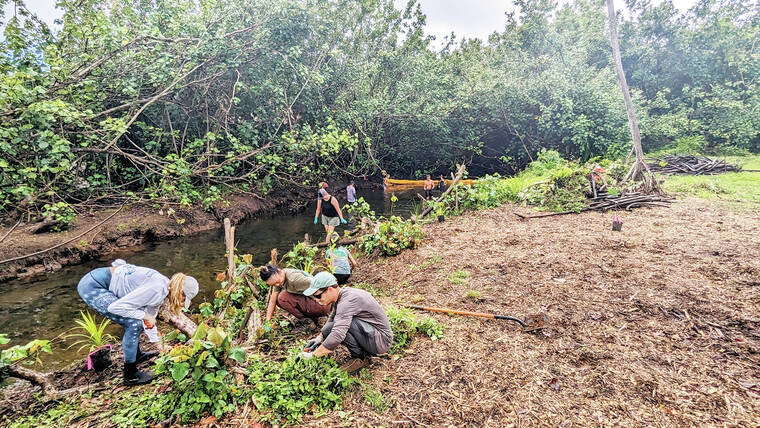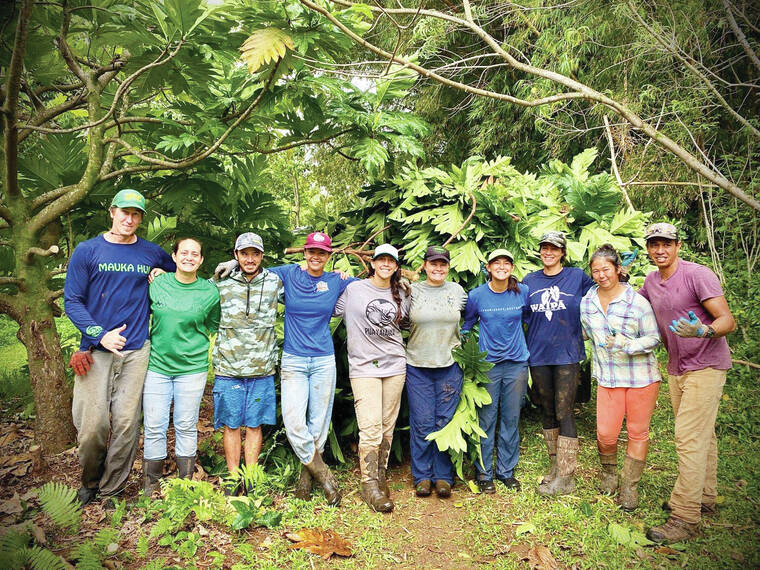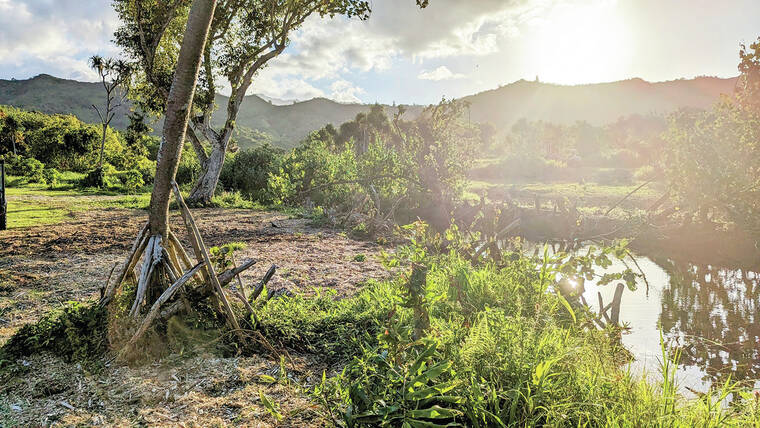HANALEI — After nearly a decade of work, environmental nonprofit Waipa Foundation is wrapping up its Waipa Stream Restoration Project, a multifaceted effort to restore its namesake ahapua‘a’s natural resources and promote agricultural land use.
Almost entirely owned by Kamehameha Schools, Waipa ahapua‘a is managed by Waipa Foundation through a long-term lease agreement. Because of this, the foundation has been able to create an especially cohesive restoration project.
“It hasn’t really been divided up into many private properties like a lot of other places have,” said Waipa Foundation hydrologist and stream projects manager Matt Rosener. “So we do have a unique opportunity to manage the land and the water on a watershed basis, which makes this kind of work a lot easier.”
A core aspect of the project has focused on converting cesspools in the area. Cesspools can discharge fecal and chemical waste into nearby groundwater, where the pollutants make their way into streams and rivers before entering nearshore waters. While Kaua‘i’s approximately 14,000 cesspools are an islandwide issue, Hanalei’s geological conditions make it particularly susceptible to cesspool pollution.
“Anywhere where you’re in kind of a sandy coastal plain area around Hawai‘i, you’re going to be in soils that just drain really quickly,” Rosener explained. “And these low elevation areas, it’s only a matter of a few feet to the water table. You’re counting on the soil to treat the sewage that comes out of the septic tank, and if you just have the water run through the ground in a matter of minutes, you’re not getting a lot of treatment before that stuff gets into the groundwater.”
Largely funded through Hawai‘i Department of Health grants, Waipa Foundation replaced 12 cesspools in the ahapua‘a, including all tanks in the Waikoko watershed and all but two in the Waipa watershed. An additional Waipa cesspool is planned for conversion later this year.
Rosener told The Garden Island that water quality changes as a result of these conversions have been staggering.
“What we were able to show was fecal indicator bacteria levels coming down substantially — basically reduced by 50 percent over the course of our projects,” he said.
It’s not just human feces polluting the waters, though. Feral pigs have been found wallowing and defecating in the streams, adding excess mud and feces to the water.
Additionally, the nonnative hogs frequently dig up both the area’s native plants and gardens, including Waipa Foundation’s lo‘i kalo (taro patches).
To address the pigs’ impacts on both streams and vegetation, the foundation has also undergone feral ungulate removal efforts, calling on local hunters and trappers to cull the population.
However, Rosener stressed that the foundation has no intentions to eradicate pigs from the area.
“It’s not even possible in places like Waipa, where the pigs can just move over the ridges from one watershed to the next,” he said. “But we wanted to control the population, because we were experiencing quite a bit of impact in terms of damage from the pigs to the crops.”
The project’s restoration efforts didn’t stop there, though.
To filter water coming from lo‘i kalo, the foundation constructed wetlands below the fields that naturally remove pollutants before reaching nearby streams.
To create more sustainable lo‘i kalo, the foundation established several best management practices, including switching from wet tilling to dry tilling and allowing lo‘i to rest at least six months after it’s harvested before replanting.
And to prevent erosion, the foundation carefully replaced existing vegetation along the streams with grass seeding and outplanting, creating more resilient stream banks.
With all of these efforts together, the foundation has seen significant improvements in the health of the streams.
Following the removal of invasive hau bushes — which can create stagnant water by clogging waterways — the streams’ dissolved oxygen levels increased dramatically. Bioassessment surveys conducted by the University of Hawai‘i have found significantly improved habitat conditions, and Waipa Foundation snorkel surveys found that native fish populations had more than doubled since the project began.
While Rosener championed the project’s results, he stressed that none of it could have happened without frequent help from volunteers.
“There’s really no way we could have gotten done what we got done on the stream project without all the different groups who come through,” he said. “Especially for the community volunteer workdays that we run the fourth Saturday of every month. We appreciate it.”
And while the Waipa Stream Restoration Project may have concluded, Rosener added that the foundation’s work is likely far from over.
“I don’t know if the project will ever be complete,” he said. “We’ve kind of reached a milestone point where we’ve finished off all the work that we intended to do with that specific grant, but I’m sure that work on the stream restoration project will continue into the future.”
•••
Jackson Healy, reporter, can be reached at 808-647-4966 or jhealy@thegardenisland.com.







